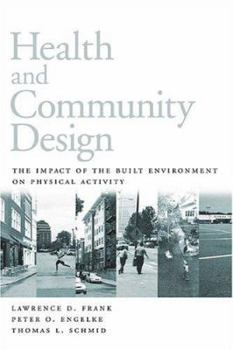Health and Community Design: The Impact of the Built Environment on Physical Activity
Select Format
Select Condition 
Book Overview
Health and Community Design is a comprehensive examination of how the built environment encourages or discourages physical activity, drawing together insights from a range of research on the relationships between urban form and public health. It provides important information about the factors that influence decisions about physical activity and modes of travel, and about how land use patterns can be changed to help overcome barriers to...
Format:Paperback
Language:English
ISBN:1559639172
ISBN13:9781559639170
Release Date:May 2003
Publisher:Island Press
Length:271 Pages
Weight:1.50 lbs.
Dimensions:0.6" x 6.1" x 9.0"
Customer Reviews
2 ratings
Public Health and Planning finally reconverge
Published by Thriftbooks.com User , 18 years ago
This is a very well written and presented book about the physical elements of our community design that compel us to discriminate certain forms of transportation over others (i.e., motorized over car). The implications are about health--getting enough "moderate" exercise each day. "Moderate" exercise is more accessible than the various forms of specialized exercises we have (i.e., sports teams, going to the gym). Exercise can be utilitarian in nature--it doesn't have to be specialized. For instance, transportation can be a form of exercise. When it is utilitarian--built into activities we have to be doing anyway--it saves time, instead of being "another thing to add to the schedule" it is killing two birds w/one stone. Certain features and designs in the built environment are more helpful in encouraging the general population to using forms of moderate exercise (i.e., walking, biking) as transportation. The idea of "utilitarian exercise" is cool--I wish they would have talked more about other (nontransportation) forms, such as gardening, etc. The book also contains an excellent but brief review of the history of community health and planning at the beginning--how "solving" the health problems of the past era have led to the health problems of this era. The goal this time is to find a real solution--not one that leads to different types of health problems all over again. Most satisfyingly, it is very well written and easy to read through. Any jargon is well-explained, and it is kept to a minimum. Based on quantitative science, it never (to my recollection) leaps to conclusions its data could not support--rather the authors highlight questions which the data produce and need to be pursued further.
excellent but probably will be outdated in a few years
Published by Thriftbooks.com User , 20 years ago
This book is one of the first to address the relationship between suburban sprawl and Americans' sedentary habits. The authors point out: 1) that Americans drive more and walk less than residents of other affluent nations 2) that Americans have become more sedentary and fatter in recent decades 3) that Americans exercise more when they live in more pedestrian-friendly environments, and 4) that Americans are unable to walk as much as they would like because most American cities and suburbs are built by highway engineers and government planners to discourage pedestrian traffic; streets are too wide to safely walk, zoning codes mandated densities so low that shops are often not within walking distance of residences, and federal housing regulation has encouraged streets to be disconnected to each other that nearly all journeys require a stop at a high-speed, congested arterial. Because this book was built in 2003, the authors devote relatively little space to the connection between sprawl, lack of exercise and obesity. In recent years, some studies have begun to document this connection, and I hope that the authors come out with a second edition addressing these issues.





